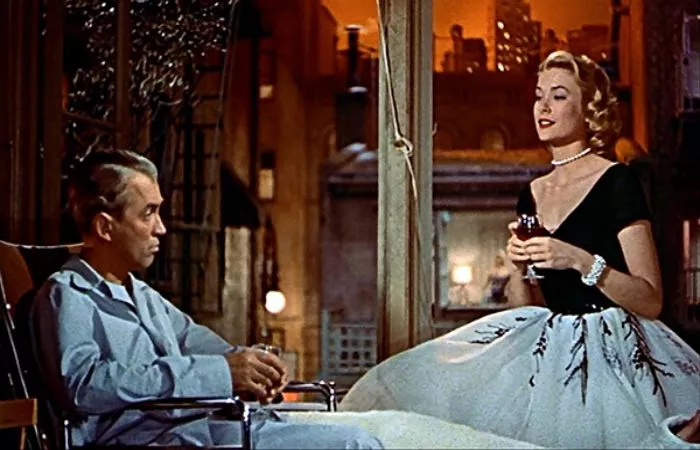“Rear Window,” directed by Alfred Hitchcock and released in 1954, is a classic thriller that keeps viewers on the edge of their seats as they follow the protagonist’s investigation into a potential murder. In the film, photographer L.B. “Jeff” Jefferies (played by James Stewart) becomes confined to his apartment due to a broken leg and passes the time by observing his neighbors through his rear window. As Jeff becomes increasingly convinced that one of his neighbors has committed murder, he enlists the help of his girlfriend Lisa Fremont (played by Grace Kelly) and his nurse Stella (played by Thelma Ritter) to uncover the truth.
Suspicion and Intrigue:
Throughout “Rear Window,” Hitchcock expertly builds suspense and tension as Jeff and the audience are drawn deeper into the mystery unfolding across the courtyard. From the eccentric sculptor Thorwald (played by Raymond Burr) to the newlywed couple, the newlywed couple, the newlywed couple, the newlywed couple, and the struggling songwriter, each neighbor provides a glimpse into a different aspect of human nature. As Jeff pieces together clues and forms theories about the possible murder, viewers are kept guessing about the identity of the killer and the truth behind the mysterious disappearance of Thorwald’s wife.
The Climactic Revelation:
The climax of “Rear Window” occurs when Jeff’s suspicions about Thorwald are confirmed, and he witnesses Thorwald disposing of his wife’s body in a trunk. In a tense confrontation, Jeff realizes that he has uncovered the truth but is unable to stop Thorwald from leaving the apartment. As Lisa and Stella race to Jeff’s apartment to confront Thorwald, the tension reaches its peak, leading to a dramatic showdown between Jeff and the killer.
The Identity of the Killer:
Ultimately, the killer in “Rear Window” is revealed to be Lars Thorwald, the brooding and mysterious neighbor whose actions arouse Jeff’s suspicions. Thorwald’s motive for the murder is financial gain, as he stands to inherit his wife’s considerable wealth upon her death. As Jeff and Lisa piece together the evidence and unravel Thorwald’s scheme, they realize the extent of his deception and the danger they are in.
Themes of Observation and Voyeurism:
At its core, “Rear Window” explores themes of observation, voyeurism, and the nature of perception. Jeff’s confinement to his apartment and his reliance on his rear window to observe his neighbors reflect the human tendency to voyeuristically observe the lives of others. Through Jeff’s voyeuristic gaze, Hitchcock invites viewers to consider their own relationship to observation and the ethical implications of watching others without their knowledge or consent.
Moral Dilemmas and Ethical Questions:
“Rear Window” raises ethical questions about the limits of observation and the responsibility of the observer to intervene in the lives of others. As Jeff becomes increasingly invested in the lives of his neighbors and the mystery unfolding before him, he grapples with the moral dilemma of whether to intervene in Thorwald’s actions or to remain a passive observer. Similarly, viewers are forced to confront their own ethical beliefs and consider what they would do in Jeff’s situation.
The Power of Perception:
Throughout “Rear Window,” Hitchcock plays with the theme of perception and the ways in which it can be manipulated. From Jeff’s initial suspicions about Thorwald to his growing certainty of the murder, perception shapes the narrative and drives the protagonist’s actions. As Jeff’s perception of reality is called into question, viewers are forced to reevaluate their own perceptions and consider the possibility of multiple truths existing simultaneously.
The Legacy of “Rear Window”:
“Rear Window” remains a classic of the thriller genre, celebrated for its innovative storytelling, masterful direction, and iconic performances. Hitchcock’s expert manipulation of suspense and tension keeps viewers guessing until the very end, while the film’s exploration of voyeurism and ethical dilemmas continues to resonate with audiences today. As one of Hitchcock’s most enduring and influential works, “Rear Window” remains a testament to the power of perception and the enduring allure of the mystery genre.
Conclusion
In conclusion, the killer in “Rear Window” is revealed to be Lars Thorwald, the enigmatic neighbor whose actions arouse suspicion and intrigue in protagonist L.B. “Jeff” Jefferies. Through its masterful storytelling and exploration of themes such as observation, voyeurism, and the nature of perception, “Rear Window” remains a classic of the thriller genre and a testament to Alfred Hitchcock’s enduring legacy as a master filmmaker.
Related Topics:
60-year Controversial Masterpiece – Psycho
Why is Silence of the Lambs so highly rated?
Top 10 Thriller Movies – Brief Introductions

